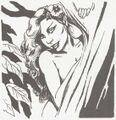Nymph: Difference between revisions
1d4chan>Nubnuber No edit summary |
m (21 revisions imported) |
||
| (7 intermediate revisions by 2 users not shown) | |||
| Line 13: | Line 13: | ||
D&D is also home to several members of the extended nymph family tree, including [[Dryad]]s, [[Hamadryad]]s, [[Oread]]s and [[Naiad]]s (which seem to be an amalgamation of Niads and Oceanids in their fluff). | D&D is also home to several members of the extended nymph family tree, including [[Dryad]]s, [[Hamadryad]]s, [[Oread]]s and [[Naiad]]s (which seem to be an amalgamation of Niads and Oceanids in their fluff). | ||
== | ==4th Edition== | ||
[[File:Nymph spring autumn 4e.jpg|left|200px|thumb|Spring and Autumn Nymphs]] | [[File:Nymph spring autumn 4e.jpg|left|200px|thumb|Spring and Autumn Nymphs]] | ||
[[File:Nymph winter summer 4e.jpg|right|200px|thumb|Winter and Summer Nymphs]] | [[File:Nymph winter summer 4e.jpg|right|200px|thumb|Winter and Summer Nymphs]] | ||
In | In [[Dungeons & Dragons 4th Edition]], nymphs didn't appear until the 3rd [[Monster Manual]], but received quite the fluff update. Daughters of the four seasons and fathered by the four winds, the nymphs are fickle, tempestuous creatures who consider life a grand game in which their having fun is the only thing that matters - and where mortals are intriguing, but ultimately replaceable, toys. Beautiful but untrustworthy, they are divided into five categories; Spring, Summer, Autumn, Winter and Wood. | ||
Spring Nymphs fixate on the way that life is always replenished and enhanced by spring. They are the most hedonistic of the nymphs, and live to amuse themselves and their infinite hunger for sensation, reveling in manipulating mortals to become their playmates. Their kiss can sear a mind with pure passion, and their song can ensnare the weak-willed, rendering them prey to the hypnotic allure of their sweet personal scent. | Spring Nymphs fixate on the way that life is always replenished and enhanced by spring. They are the most hedonistic of the nymphs, and live to amuse themselves and their infinite hunger for sensation, reveling in manipulating mortals to become their playmates. Their kiss can sear a mind with pure passion, and their song can ensnare the weak-willed, rendering them prey to the hypnotic allure of their sweet personal scent. | ||
| Line 64: | Line 64: | ||
Nymphs of Theros can appear in both masculine and feminine forms. | Nymphs of Theros can appear in both masculine and feminine forms. | ||
== | ==Pathfinder== | ||
On [[Golarion]], Nymphs and Dryads in the traditional D&D mold exist, but so do a number of related species - Lampads, Naiads, Nereids, Oceanids, Hamadryads, and Hesperides. | On [[Golarion]], Nymphs and Dryads in the traditional D&D mold exist, but so do a number of related species - Lampads, Naiads, Nereids, Oceanids, Hamadryads, and Hesperides. | ||
==Gallery== | ==Gallery== | ||
<gallery> | <gallery> | ||
Nymph MCV1.jpg | |||
Nymph MM 2e.png|A [[Tony DiTerlizzi|DiTerlizzi]] style nymph. | Nymph MM 2e.png|A [[Tony DiTerlizzi|DiTerlizzi]] style nymph. | ||
Half nymph Dragon 313.jpg|Half-Nymph (''[[Dragon Magazine|Dragon]] #313'') | |||
unseelie nymph MCAV4.jpg|Unseelie Nymph | |||
nymph B1.png|Pathfinder | |||
</gallery> | </gallery> | ||
[[Category: Monsters]][[Category:Dungeons & Dragons]][[Category:Greek Mythology]] | [[Category: Monsters]][[Category:Dungeons & Dragons]][[Category:Greek Mythology]] | ||
Latest revision as of 08:56, 22 June 2023
 | This article or section is about Monstergirls (or a monster that is frequently depicted as a Monstergirl), something that /tg/ widely considers to be the purest form of awesome. Expect PROMOTIONS! and /d/elight in equal measure, often with drawfaggotry or writefaggotry to match. |
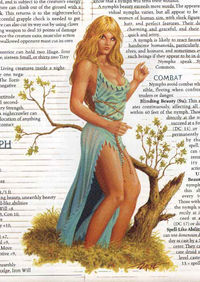
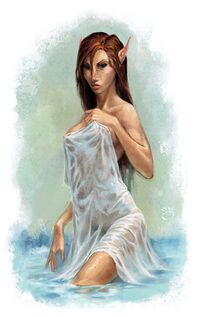
Nymphs are a species of female spirits originating from Greco-Roman mythology and one of Western culture's earliest forms of monstergirls. Distantly related to the gods, but far less powerful, nymphs are spirits tied to various aspects of nature - their most common subdivisions being the famous Dryads (tree spirits) and less famous but still somewhat recognizable Niads (spring & river spirits) and Oceanids (ocean spirits), but there are many, many others, including Oreads (mountain spirits), Limoniads (meadow spirits), Limniads (lake/marsh/swamp spirits), and Napaea (valley & glen spirits). Nymphs are particularly known for being pursued by amorous menfolk, from humans to satyrs to gods.
Though the name is taken from Western culture, the concept of "beautiful female spirit" is pretty universal, and beings akin to nymphs show up in almost every polytheistic mythos.
Despite this, nymphs have never really enjoyed a lot of attention in /tg/ related works, simply because the concept is both extraordinarily broad ("nymph" can, realistically, refer to any beautiful female fey, from an elf to a mermaid) and surprisingly weak - a nymph is basically just a super-beautiful "non-human, but doesn't look it" woman.
Dungeons & Dragons has traditionally included nymphs over multiple editions, but they're not really acknowledged much, simply because they're obvious fapbait and, unlike the succubus or lamia, they don't really have anything to distinguish them beyond that. Your D&D nymph is basically a high level, max charisma, female elf sorceress (Enchanter) multiclassed with druid with one unique ability: if you see her naked, you gotta make a save to avoid dying, and then another save to not go blind if you live. Apparently because they're "so beautiful". That's really it. The 2e monster manual doesn't even detail how they procreate.
D&D is also home to several members of the extended nymph family tree, including Dryads, Hamadryads, Oreads and Naiads (which seem to be an amalgamation of Niads and Oceanids in their fluff).
4th Edition[edit]
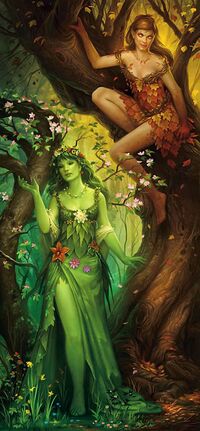
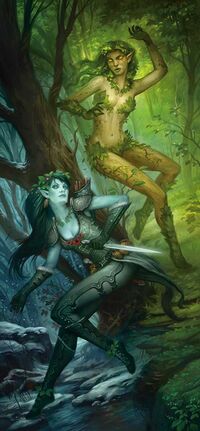
In Dungeons & Dragons 4th Edition, nymphs didn't appear until the 3rd Monster Manual, but received quite the fluff update. Daughters of the four seasons and fathered by the four winds, the nymphs are fickle, tempestuous creatures who consider life a grand game in which their having fun is the only thing that matters - and where mortals are intriguing, but ultimately replaceable, toys. Beautiful but untrustworthy, they are divided into five categories; Spring, Summer, Autumn, Winter and Wood.
Spring Nymphs fixate on the way that life is always replenished and enhanced by spring. They are the most hedonistic of the nymphs, and live to amuse themselves and their infinite hunger for sensation, reveling in manipulating mortals to become their playmates. Their kiss can sear a mind with pure passion, and their song can ensnare the weak-willed, rendering them prey to the hypnotic allure of their sweet personal scent.
Summer Nymphs are the oldest and wisest of their ilk, and live in contemplative wonder of the mysteries of eternity, but have learned no compassion with their wisdom. They amuse themselves with a strange and enigmatic game, alternatively aiding and attacking the denizens of the mortal realm or the Feywild alike as part of their own mysterious goals. Their vision can burn with the brilliance of the midsummer sun, and their touch scramble a mind with an influx of alien wisdom. If truly pressed, they can summon violent summer storms to defend themselves and their followers - beasts and plants and lesser fey.
Autumn Nymphs are obsessed with stories, and will readily trade them with mortals; in many ways, they are the most docile of their sisters, but woe betide the bargainer who refuses to live up to their end of the deal and share a story in return! They wreak a subtle vengeance, deluging their victim with dark and hidden secrets, overwhelming their minds with knowledge they cannot bear and ruining their lives. Ironically, autumn nymphs are the most melancholic of their kind, for they see life in perpetual decline.
Winter Nymphs are preachers of the philosphy that only the strongest survive, hunting monsters and humanoids alike to take their heads as trophies in bloody raids.
Wood Nymphs are autumn nymphs who have succumbed to their melancholy and begun to replace it with rage, being consumed by an urge to battle for nature's survival that causes them to begin merging with a single tree. This path can ultimately cause them to transform into either hamadryads or dryads.
Odyssey of the Dragonlords[edit]
In Odyssey of the Dragonlords, nymphs are a prominent fey race, born from the elements themselves and with a strong tie to the natural world. Of all the fey of Thylea, they are arguably the most civilized, since they find mortals fascinating and frequently interact with them, often integrating themselves into elven communities or even becoming adventurers. They are, however, a chaotic race that worships beauty as the supreme virtue, and views the world through a correspondingly crooked lens; to a nymph, "beauty and ugliness" have the same meaning as "good and evil", and that doesn't always mesh up with the views of other races. Nymphs seek to create beauty, promote the creation of beauty, protect beautiful creatures and objects, and eradicae that which destroys or damages beauty or otherwise promotes ugliness.
Thylea is home to six distinct nymph subraces; Aurae are nymphs of the sea, the night sky, currents, breeezes and constellations. Niads are nymphs of fresh water, and thusly the subrace most likely to interact with mortals. Nereids are nymphs of the ocean deep, who are responsible for safeguarding coral reefs. Oceanids are shapeshifting sea nymphs with a love of fun and entertainment; of all the nymphs, they are closest to their elemental nature, and as such they can't leave the ocean for very long, as the seperation drives them mad and ultimately will kill them. Oreads are mountain, sky and cloud nymphs who are notable for their territoriality and their unusual love of hunting - however, they share the same "beauty centric" viewpoint as their kinsfolk, and thusly they will punish poor and needlessly cruel hunters who dare stray into their territory. Dryads need little explanation, as those of Thylea are all but identical to the "common" 5e Dryad.
Two things make Thylean nymphs particularly unusual. Firstly, nymphs of Thylea are not a mono-gendered race, but can be found in a spectrum of appearances; female, male, both or neither. That said, their obsession with beauty does impact them - oceanids are noted as unusual for their sheer propensity towards being male-gendered, and even the most masculine nymph is still a feminine-ish "pretty boy" than some rugged ugly brute. Secondly, their fascination with learning about the world around them makes them a playable race. Their fascination is also mentioned to lead them to some other, rather unusual actions towards her fellow sentient humanoids, like considering such "property" or part of their "collection". The book mentions that nymphs like to show off their collection of settler races to other nymphs and will even fight with each other over their favourites. It is not stated whether nymphs try to arrange fights between their favourites, pokemon-style, but there is nothing stopping you from making that part of your nymph character of campaign.
- Ability Score Modifiers: +2 Charisma, +1 Wisdom
- Size: Medium
- Speed: 30 feet
- Vision: Normal
- Enthralling Beauty: You have Proficiency in the Persuasion skill and can cast Charm Person once per short rest, using Charisma as your spellcasting ability score.
- Nymph Magic: You gain access to two spell-like abilities depending on your Nymph Ancestry; one at 3rd level, one at 7th level. Both spell-like abilities can be used once per short rest and use Charisma as their spellcasting ability score.
- Nymph Ancestry: Choose the Aurae, Dryad, Naiad, Nereid or Oread subrace.
Aurae: You have Darkvision 60 feet and Advantage on Wisdom (Survival) checks made to navigate by the stars. Your Nymph Magic SLAs are Faerie Fire (3rd level) and Levitate (7th level).
Dryad: You can speak to plants and animals, and have Advantage on Wisdom (Survival) checks made in forested regions. Your Nymph Magic SLAs are Goodberry (3rd level) and Barkskin (7th level).
Naiad: You can hold your breath for 1 hour and have a Swimming speed of 40 feet. Your Nymph Magic SLAs are Create Or Destroy Water (3rd level) and Control Water (7th level).
Nereid: You can breathe underwater and have a Swimming speed of 40 feet. Your Nymph Magic SLAs are Fog Cloud (3rd level) and Water Walk (7th level).
Oread: You have Darkvision 60 feet and gain Advantage on Wisdom (Survival) checks made in steppes, rocky islands, and mountainous regions. Your Nymph Magic SLAs are Hunter's Mark (3rd level) and Misty Step (7th level).
Theros[edit]
Being the Magic: The Gathering plane inspired by Greco-Roman mythology, Theros is home to its own variety of nymphs. Most of the lore about them, however, is to be found in Mythic Odysseys of Theros, the setting splatbook for Theros in Dungeons & Dragons 5th Edition.
According to this book, in addition to the standard D&D Dryad, Theros is home to the following Nymph subraces:
- Alseid: A solar nymph associated with fields, meadows and plains.
- Lampad: A nymph of the Underworld - that is, both the Underdark and the realm of the dead.
- Naiad: A sea nymph.
- Oread: A wild, aggressive nymph that embodies fire, lava, and the destructive capabilities of the earth.
Nymphs of Theros can appear in both masculine and feminine forms.
Pathfinder[edit]
On Golarion, Nymphs and Dryads in the traditional D&D mold exist, but so do a number of related species - Lampads, Naiads, Nereids, Oceanids, Hamadryads, and Hesperides.
Gallery[edit]
-
-
A DiTerlizzi style nymph.
-
Half-Nymph (Dragon #313)
-
Unseelie Nymph
-
Pathfinder
